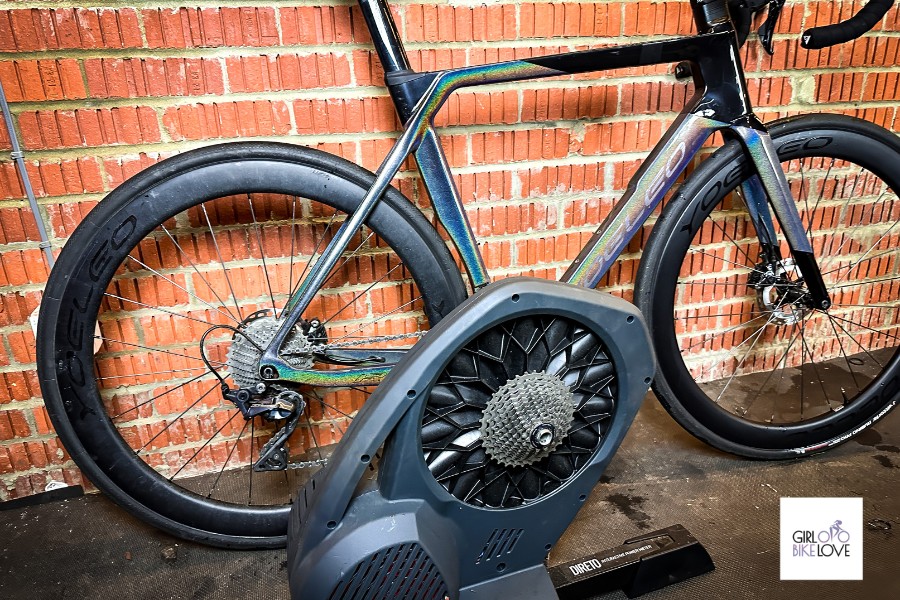Cycling indoors in the past decade has become huge. We have people using turbo trainers and exercise bikes and even remotely participating in online spin classes on singing and dancing spin bikes. It’s much easier to get your fitness fix at home now, and we couldn’t be happier with how the industry is progressing.
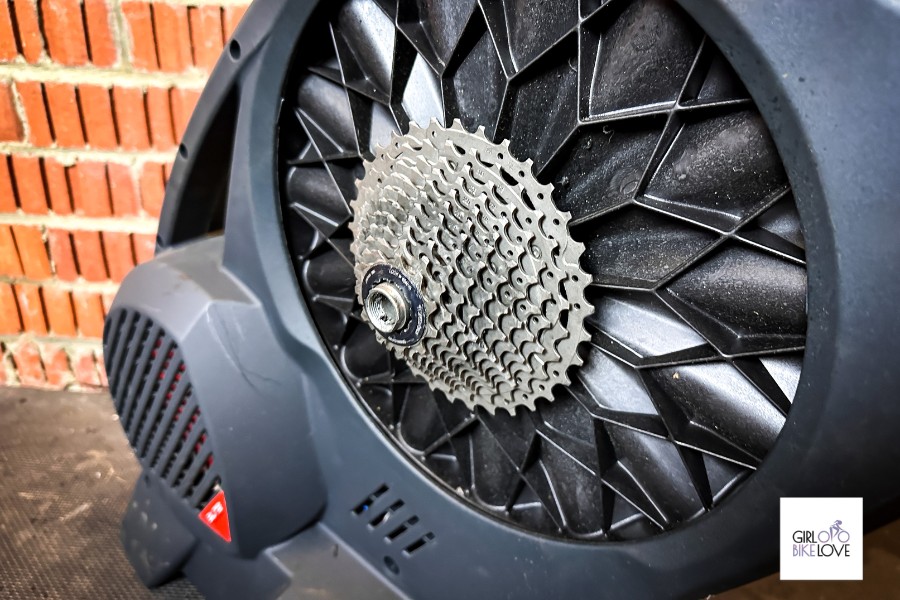
Here at Indoor Cycling Love, we have an amazing community of indoor cyclists and fitness enthusiasts. A question that comes up all the time from our subscribers is, “How do I maintain my indoor bike trainer?” In this article, we’re going to be answering that by discussing the following:
- Do Bike Trainers Need Maintenance?
- Why Is It Important To Maintain An Indoor Bike Trainer?
- How To Maintain An Indoor Bike Trainer
- How Often Should You Clean Your Bike Trainer?
Types of Indoor Trainers
Indoor trainers come in a few different types; depending on your use, you will get a very different experience. Here’s what you need to know:
1. Wheel On Trainers
The first type we call wheel on trainers. These are where you attach the whole bike to the trainer itself, and the rear wheel spins while the trainer puts the resistance against the tire itself on a small roller.
They are very cheap to buy, take literally minutes to set up and start training, and fold away, making them very easy to store. The drawbacks of these wheel-on trainers are they are very noisy, wear through your components quickly, and only a select few offer smart capabilities.
2. Direct Drive Trainers
Direct drive trainers are where to attach the bike. You need to remove the rear wheel and insert the trainer into the frame. It requires the user to remove the cassette or have another on the trainer, which we recommend. They are what many people call smart trainers and are commonly used for applications such as Zwift.
They give an amazing experience and are very quiet compared to wheel-on trainers. Most of them can automatically change resistance, and some even can be linked up with additional parts to simulate climbing. The drawback of these is they are more expensive, and getting your bike in can take longer.
You can also read our detailed guide about the differences between a direct-drive and a wheel-on trainer and how you can pick the best for you.
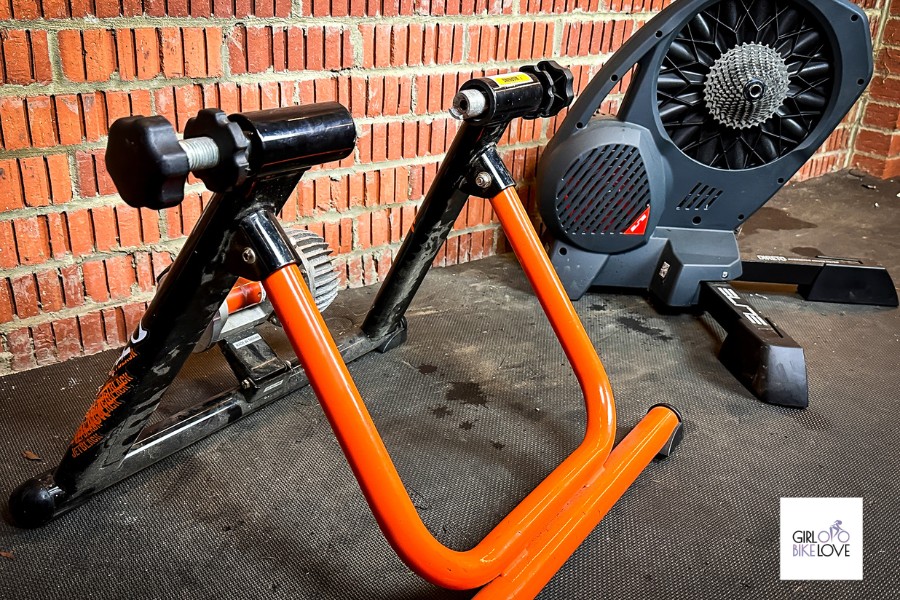
Do Bike Trainers Need Maintenance?
Anything mechanical that you own will require maintenance. There’s no avoiding it. You can do a lot for your bike trainer to help prolong its life and make the experience great for you too. It’s also very important to understand that it’s not just the trainer you need to worry about, but you also need to look after the bike attached to it.
Why Is It Important To Maintain An Indoor Bike Trainer?
There are many reasons why you will want to stay on top of our bike trainers when it comes to maintenance. Here are our top reasons:
1. Personal Experience
A well-maintained turbo trainer will give you a much better experience when being ridden compared to a poorly maintained turbo trainer. It’s smoother, quieter, and much more responsive when going into those sprints and working at higher resistances.
2. Longevity
The first thing to mention is longevity. The better you can maintain your trainer, the longer it is going to last. I have had a trainer last as little as a year for me, which I could have looked after better. Compared to the same model trainer, which has lasted twice as long and continues to perform just from servicing it.
3. Performance
As someone who has spent a lot of time on turbo trainers, I have found that you can produce much more power if your trainer is well-serviced and well-looked after. The smoother the machine can run, the better experience you will have when it comes to saving wattage and smashing those personal bests.
4. Noise
Turbo trainers tend to be a little noisy, and although there are many ways to reduce turbo trainer noise, if you don’t look after it, it is going to get a lot noisier. By staying on top of the maintenance, you will find everything to work much quieter and feel much smoother.
5. Safety
Another factor that is very important when it comes to indoor bike trainers is safety. If they are not well looked after, you might approach some concerns. You might find the gearing to slip, which could cause you to fall or hurt yourself. There’s also a chance that parts and bolts can work loose over time.
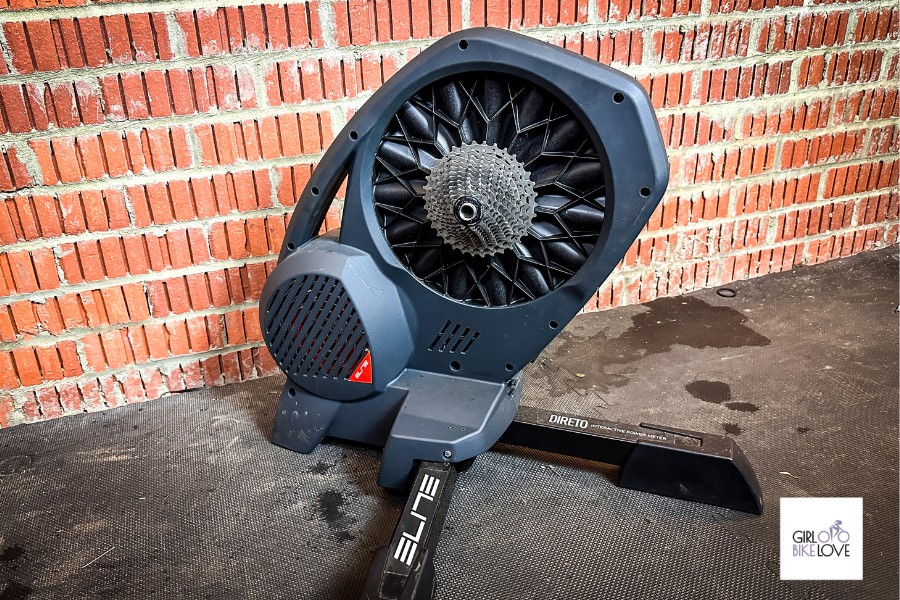
How To Maintain An Indoor Bike Trainer
Now for the fun bit. Next, we are going to speak about how you can maintain your trainer. We recommend going through this process every two weeks if you ride your bike a lot or monthly if you only ride it occasionally.
This is the process I have done for years, and it not only maintains your indoor bike trainer well but also gives you the best life out of your equipment and a great riding experience. A lot of the time, we will be working not just on the trainer but also on the bike too.
What Will You Need?
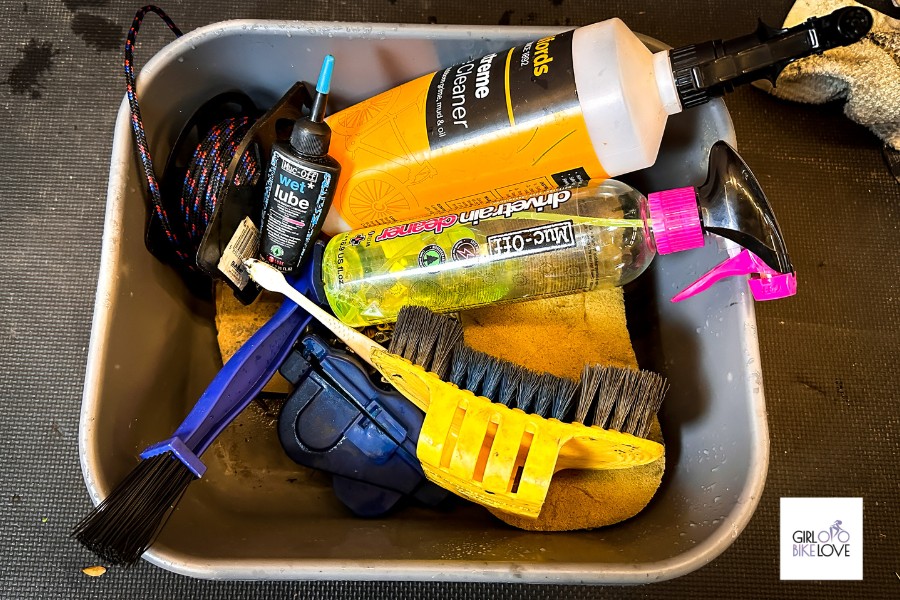
To successfully maintain your indoor bike trainer, you will not need much. Here’s what we recommend you have:
- Bike Cleaning Wash
- Sponges
- Brushes
- Degreaser
- Allen Keys
- Screwdriver
- Cleaning Cloths
- Form Of Bike Lubrication
- Bike Stand (Optional)
- Chain Cleaner (Optional)
Step One: Remove The Bike From The Trainer
Before we even think about looking at the turbo trainer, we need to get the bike removed. If you are on a wheel-on trainer, you will need to take it straight out. Remove and attach the rear wheel if you use a direct drive trainer.
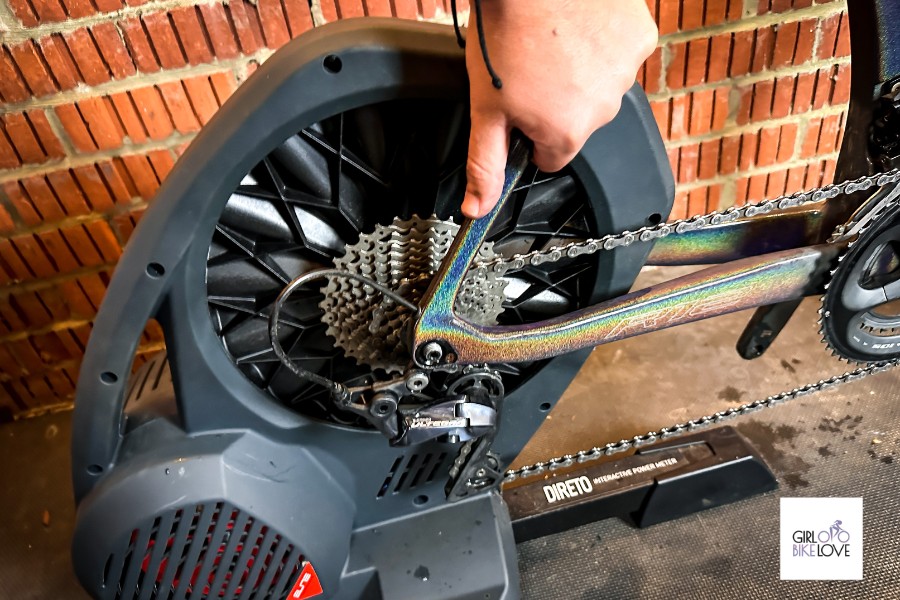
Step Two: Clean And Degrease The Bike
Next, you need to get the bike nice and clean. You will first want to rinse it down. Ensure to get everywhere nice and soaked and have a big focus on the underside of the bike. Leave it for a minute or two for the water to set in.
Once you have rinsed the bike, it’s time to start degreasing the chain, chainrings, jockey wheels, and cassette. You can do this by spraying on the degreaser and then scrubbing it all with a brush. The more dirt you can remove here, the longer it will stay cleaner. If you have a chain cleaner, we recommend using it now.
After all is degreased, rinse the bike again and then get the bike wash out and the sponge. Now it’s time to scrub all the bikes down. Have a big focus on the handlebars as what we are looking to achieve here is getting any sweat off the bike, as this can corrode your components.
Again now, rinse the bike off and either leave it to dry while you do the maintenance on the turbo trainer or dry it yourself. We recommend waiting until it’s completely dry before getting it back on the trainer.
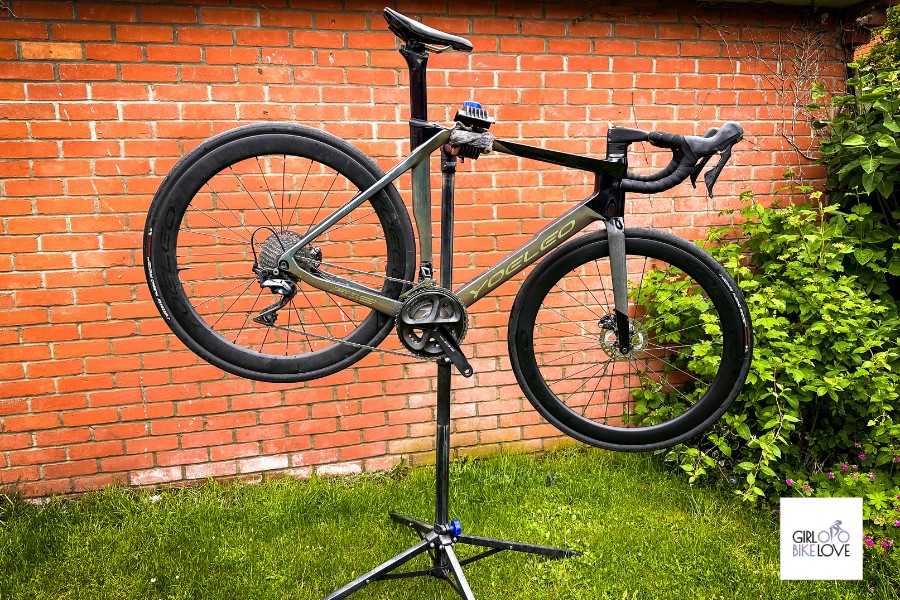
Step Three: Check The Bikes Components
Next, we need to check the bike’s components. With it all clean, this will be much less messy and much easier. Here’s what we recommend checking:
- Chain: Check stretch by either using a chain checker or pulling the chain on the chainring.
- Cassette: Check for shark teeth on the rear cogs indicating excessive wear.
- Chainrings: Check for shark teeth on all of the chainrings.
- Frame and Forks: Check for any cracks or damage the trainer might have caused.
- Handlebars: Check for any corrosion around the bars of your bike.
If there’s anything that needs attention, we recommend getting it fixed now before going back on the trainer. Hopefully, it should all be ok. If there’s anything too wrong, you will notice when the bike is being ridden.
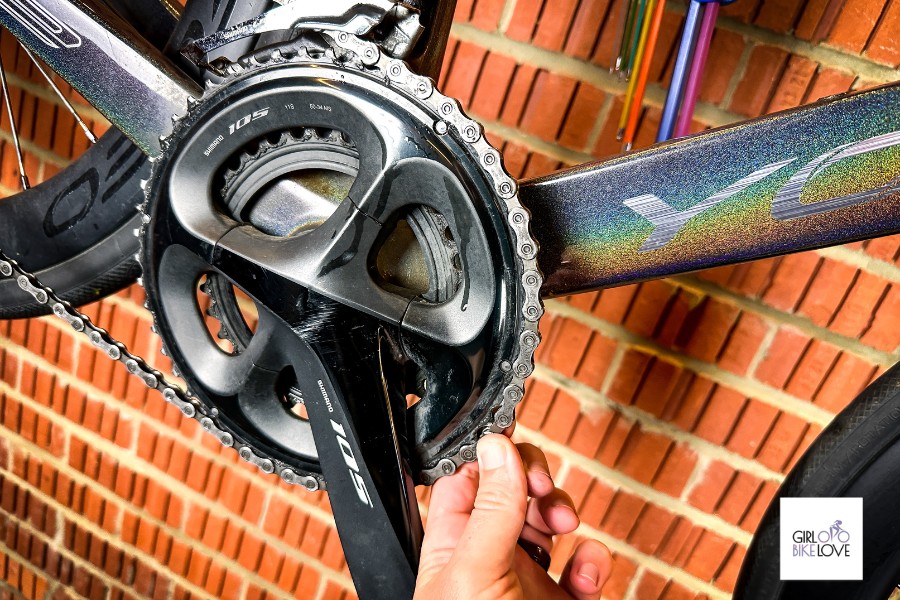
Step Four: Clean The Trainer
Now let’s leave the bike and start focusing on the indoor bike trainer. The first thing to do is clean it, and we do not recommend using a hose here. You will first want to wipe the dust off with a clean cloth.
Once you have gotten the majority off, you will want to look around the trainer, and there’s a strong chance you might find some oil or lube on it, which might have come from the bike. Spray the cloth with a degreaser and wipe any oil off where you might find it. Try not to spray the trainer directly.
If you have a cassette on the trainer, a really easy way to clean it is to get a cloth and, on one side, spray some degreaser. Then thread it through between each cog pushing it back and forth.

Step Five: Inspect The Trainer
It’s now time to inspect the trainer. This is important to do because sometimes you are able to catch problems before they cause any damage. Here’s what to look out for:
- Outer Casing: Look for any cracks or damage on the casing
- Power: Check the power lead isn’t damaged in any way
- Cassette: Look for shark teeth on the cassette to check for wear
- Feet: If you have adjustable feet, check they are completely level
- Belt: If you have internal access, it’s not a bad idea to check the belt and look for rips
Any issue you find might be worth contacting the manufacturer, looking for replacement parts, or taking it to your local bike shop to see if they can do anything. Some manufacturers recommend a belt change after a certain mileage or time being used.
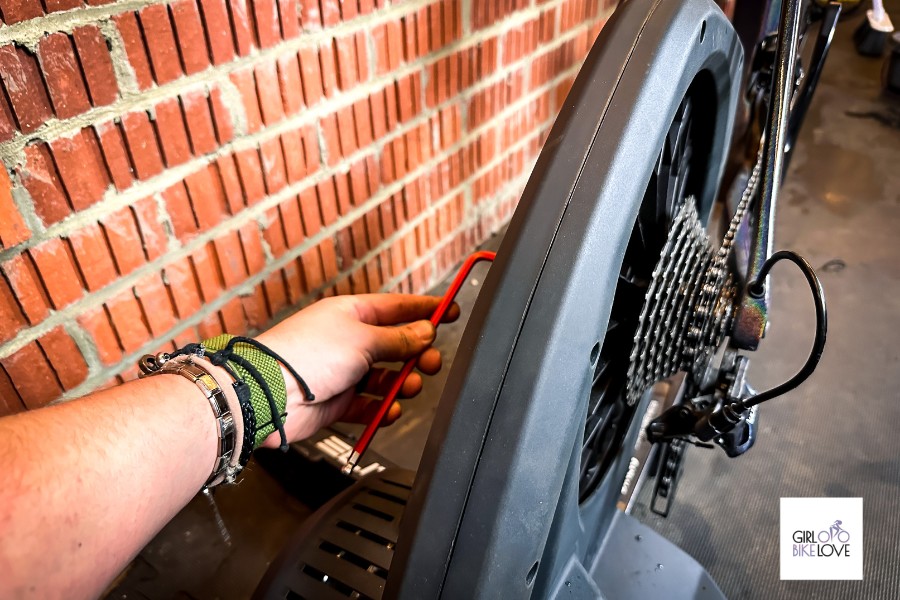
Step Six: Insert The Bike and Lubricate
Now it’s time for us to get the bike back in the trainer. Be sure to get it in properly and make sure everything is nice and tight. If you have a riser block for under the front wheel, you can insert this now.
Next, it’s time to lubricate the chain. The key to proper chain lubrication is to get as little on as possible but enough to give the chain free movement and protect it from getting rusty. I personally like to put a drop on each link and then run the chain through the system for around 30 seconds.
Then you are going to want to take a clean cloth and run the chain through. Any excess oil we want to remove now. There should be enough in the links for it to be lubricated to work properly.
Now it’s time to give it a test just to make sure everything is ok and works as it should.
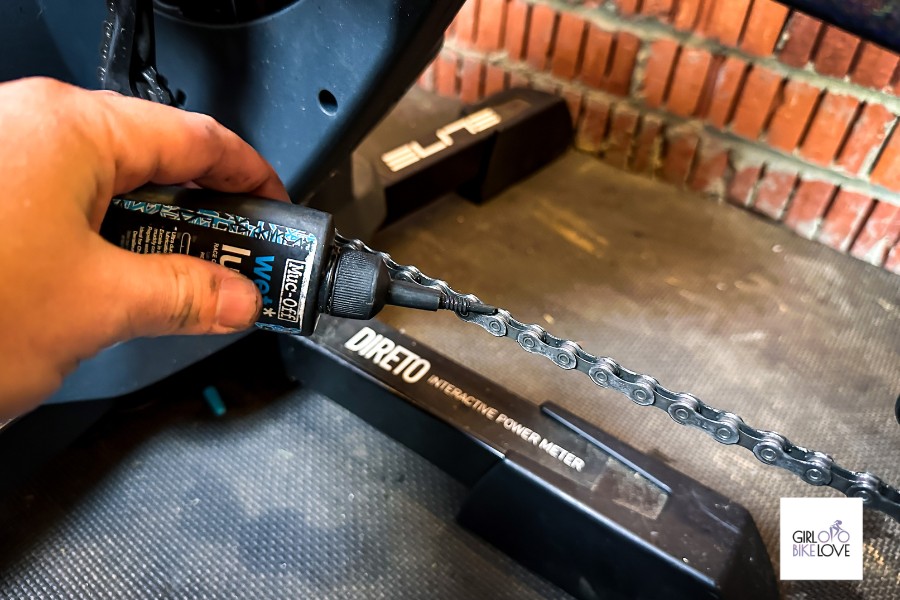
Storing Your Indoor Bike Trainer
When it comes to storing your bike trainer, a lot of indoor cyclists make the mistake of keeping it in the wrong place. The best place for an indoor bike trainer is somewhere fairly warm, dry, and where moisture can’t get to it. If you leave it in a shed where it can get cold, the belt can go brittle, which shortens its life.
A Final Note
Indoor bike trainers generally don’t require much maintenance, but you do have to look after them. They need to be cleaned regularly, and they need to run smoothly alongside the bike. It’s easy to neglect your indoor bike trainer, but this will only lead to a poor experience and a short life for your trainer.
Frequently Asked Questions
How often should you clean your bike trainer?
We recommend every two weeks if you use the bike a fair amount and it stays indoors. If you don’t use the bike and trainer much, you might want to consider monthly.
How do you lubricate a bike trainer?
Typically a bike trainer doesn’t often need lubing. It’s the chain of the bike that does. To lube a chain, you need to add a drop to every link, spin it through the system, then clean off the excess.
Do indoor bike trainers fit all bikes?
It’s always worth checking before you buy an indoor bike trainer, but you will find most modern trainers will come with adaptors to suit many different types.
Do I need a mat under my indoor bike trainer?
Having a mat has a lot of benefits, and we highly recommend it. It makes the bike trainer quieter, keeps your floor cleaner, and even looks much better.
